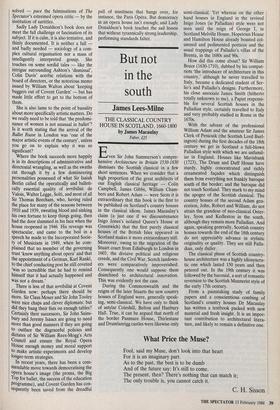But not in the south
James Lees-Milne
THE CLASSICAL COUNTRY HOUSE IN SCOTLAND, 1660-1800 by James Macaulay Faber, f25 Even Sir John Summerson's compre- hensive Architecture in Britain 1530-1830 dismisses the Scottish classical in a few short sentences. When we consider that a high proportion of the great architects of our English classical heritage ŌĆö Colin Campbell, James Gibbs, William Cham- bers and Robert Adam ŌĆö were Scots it is extraordinary that this book is the first to be published on Scotland's country houses in the classical idiom. James Macaulay's claim (a just one if we discountenance Inigo Jones's isolated Queen's House at Greenwich) that the first purely classical houses of the British Isles appeared in Scotland makes it more extraordinary still. Moreover, owing to the migration of the Stuart court from Edinburgh to London in 1603, the divisive political and religious creeds, and the Civil War, Scotch landown- ers were comparatively impoverished. Consequently one would suppose them disinclined to architectural innovation. This was evidently not the case.
During the Commonwealth and the reigns of the later Stuarts the new country houses of England were, generally speak- ing, semi-classical. We have only to think of astylar Coleshill, Belton and Hanbury Hall. True, it can be argued that north of the border Panmure House, Thirlestane and Drumlanrigg castles were likewise only semi-classical. Yet whereas on the other hand houses in England in the revived Inigo Jones (ie Palladian) style were not seen until the reign of George I, in Scotland Melville House, Hopetoun House and Hamilton House already boasted col- umned and pedimented porticos and the usual trappings of Palladio's villas of the Brenta, in the 1680s and 90s.
How did this come about? Sir William Bruce (1630-1710), dubbed by his compat- riots 'the introducer of architecture in this country,' although he never travelled to Italy, became a dedicated student of Ser- lio's and Palladio's designs. Furthermore, his close associate James Smith (hitherto totally unknown to me), a Papist responsi- ble for several Scottish houses in the Palladian style, certainly travelled to Italy and very probably studied in Rome in the 1670s.
With the advent of the professional William Adam and the amateur Sir James Clerk of Penicuik (the Scottish Lord Burl- ington) during the first decades of the 18th century we get in Scotland a full-blown Palladian style with which we are unfamil- iar in England. Houses like Mavisbank (1723), The Drum and Duff House have sturdy, highly concentrated and richly ornamented fagades which distinguish them from everything not frankly baroque south of the border; and the baroque did not touch Scotland. They mark to my mind the apogee of the Scottish classical. The country houses of the second Adam gen- eration, John, Robert and William, do not attain the grandeur of neo-classical Oster- ley, Syon and Kedleston in the south, although they remain more Palladian. And again, speaking generally, Scottish country houses towards the end of the 18th century do not appreciably advance in stylistic originality or quality. They are still Palla- dian, only duller.
The classical phase of Scottish country- house architecture was a highly idiosyncra- tic one which lasted 150 years and then petered out. In the 19th century it was followed by the baronial, a sort of romantic reversion to the Scottish Mannerist style of the early 17th century.
From a painstaking study of family papers and a conscientious combing of Scotland's country houses Dr Macaulay has written a textbook packed with new material and fresh insight. It is an impor- tant contribution to architectural litera- ture, and likely to remain a definitive one.


























































 Previous page
Previous page